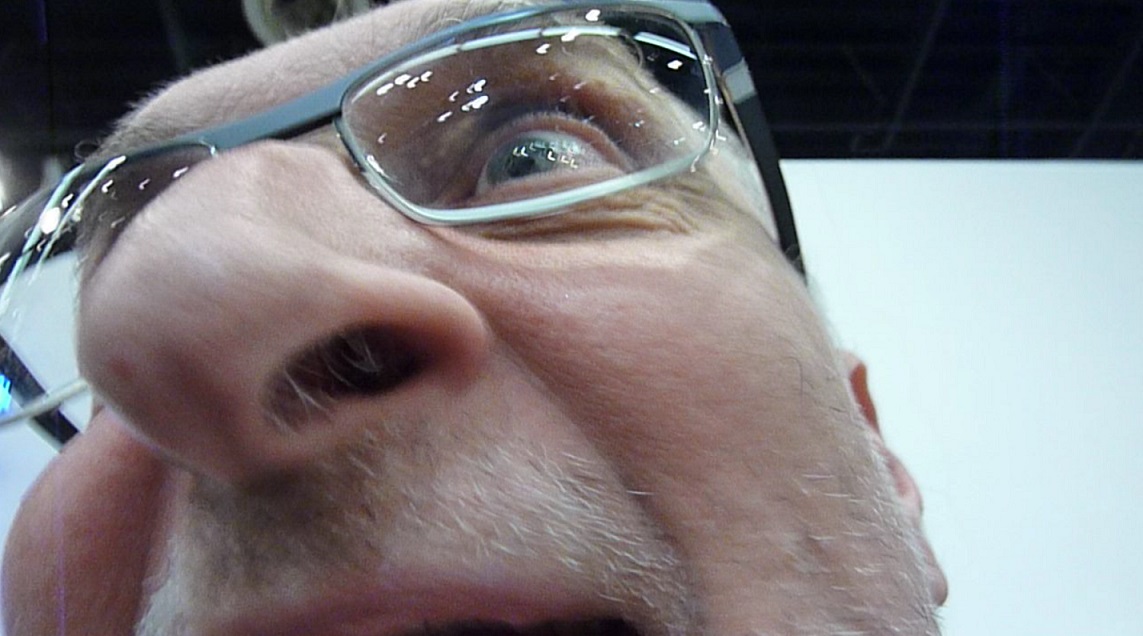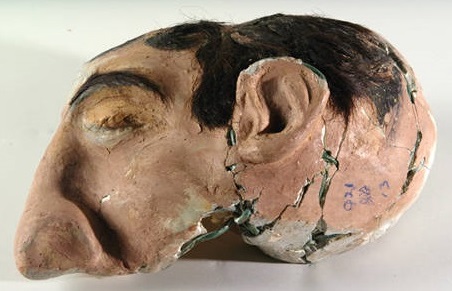gia edzgveradze
the dud smuggler (unexpected outcome)


self-portrait, Gia Edzgveradze, screenshot 2014-11-15 at 9.13.39 pm fake head, Alcatraz Federal Penitentiary, Alcatraz Island, USA
opening: Saturday, the 20th of December, at 6.30 pm
a Trieste Contemporanea and Studio Tommaseo production
in the frame of the Smuggling Anthologies project
An happy and highly anticipated return to Trieste of the Georgian artist Gia Edzgveradze, many years ago awarded the Young European Artist Trieste Contemporanea.
The artist offers on display at Studio Tommaseo The Dud Smuggler (Unexpected Outcome).
The exhibition is a development of its contribution to the Trieste conference, of last November, for the Smuggling Anthologies project, the Croatian-Slovenian-Italian initiative carried out in Italy by Trieste Contemporanea and supported by the Culture Programme of the European Union.
The personal artistic approach of Gia Edzgveradze to issues of smuggling is a poetic reflection on imprisonment, on imagination, on the “escape”. Focus of the show is a reproduction of the fake head left at night in bed for the famed only escape from Alcatraz prison – still kept in the museum of the Federal American Penitentiary and from which Don Siegel also directed the movie Escape from Alcatraz in 1979. This key element of the exhibition bounces, on the opposite wall, a lyrical and conceptual interpretation of eternal dreams of the human being: i. e. to smuggle the sun.
The exhibition is a development of its contribution to the Trieste conference, of last November, for the Smuggling Anthologies project, the Croatian-Slovenian-Italian initiative carried out in Italy by Trieste Contemporanea and supported by the Culture Programme of the European Union.
The personal artistic approach of Gia Edzgveradze to issues of smuggling is a poetic reflection on imprisonment, on imagination, on the “escape”. Focus of the show is a reproduction of the fake head left at night in bed for the famed only escape from Alcatraz prison – still kept in the museum of the Federal American Penitentiary and from which Don Siegel also directed the movie Escape from Alcatraz in 1979. This key element of the exhibition bounces, on the opposite wall, a lyrical and conceptual interpretation of eternal dreams of the human being: i. e. to smuggle the sun.
It is the artist the faulty and defective smuggler par excellence, the "dud smuggler", mentioned in the title of the exhibition: his heroic attempt of disseminating emotional knowledge and beauty is often neglected or misunderstood. The poetics of Gia Edzgveradze is strongly influenced by his previous living in the Soviet Union, a totalitarian state where at every level and on every territory there were restrictions and prohibitions and where, consequently, also smuggling existed at all levels and on each territory. A reflection on the dynamics and outcomes of the “traffic” of ideas, that at the time was everything “other” with regard to the cultural Soviet set, is carried out with the originality and the usual irony and irreverent humour that characterize the work of this artist.
A dense text written by Gia Edzgveradze will be available to the audience on categories of smuggling that existed in the Soviet Union. The artist pinpoints them in three groups, the "smugglers of rebellion", the "smugglers of paradise" and the "smugglers of the moon", his favourites ones.
Gia Edzgveradze was born in Tbilisi, Georgia, and lives and works in Düsseldorf. Among his appearances in the most prestigious museums and international art events remains unforgettable its incredible participation in the Venice Biennale in 1997, when he filled the Russian pavilion with rice and carrots. He taught in the most important German art educational institutions: the Düsseldorf Academy, the UDK Berlin and the Alanus University in Alfter (Bonn).
Smugglers of the moon (*)
by Gia Edzgveradze
I want to reflect on a particular moment from the history of smuggling, which created a painfully exotic cultural episode.
Smuggling was an important phenomenon, dividing the population of the Soviet Union into two parts: those who longed for an unknown future, and those who felt content with future that was planned and predictable.
The Soviet Union was a totalitarian state – on every level and every territory were restrictions and bans – respectively smuggling was existing there also on every level and every territory.
We had a smuggling class with a full-time occupation, and this class can be divided into three symbolic sub-groups: “smugglers of rebellion”, “smugglers of paradise” and “smugglers of the moon”.
The “smugglers of rebellion” were smuggling dissident thought from the Soviet Union to the West, and vice versa – politically active and socially sharp discourses in general, from the West to the Soviet Union. It was a big, important and dangerous mission.
The “smugglers of paradise” were serving the extensive demands of people in the Soviet Union for material goods and for all sorts of examples of the aesthetic advances of contemporary Western culture. Such goods made people happier and prouder of their existence – and sometimes snobbier, too. But more importantly this illegal trade of goods was making us aware about the natural flow of the genesis and order of things, manifested in the West, the territory where appearances of new forms were not forced to represent a specific ideology. So these smugglers were sustaining a glittering celebration: natural and everlasting flow of newly and freshly born signifiers.
But for me the most interesting and important were the "smugglers of the moon”, and in this I myself was involved. The "smugglers of the moon” were dealing with immaterial values from the whole world – from the East and the West – and also from our own past (because many forms and thoughts from the past were also banned under the Soviet regime). The goods smuggled in this case were ontological in character: philosophical texts, a variety of evidential forms and discourses of eroticism (sexual discourse was one part of it), and facts of creativity that were trying to go beyond the boundary of ordinary human consciousness (in the Soviet Union, these kinds of reflective activities were called idealistic thought) – in other words, everything that was “other” to the rational and pragmatic social communist life that was built on clearly defined moral rights. Hence, the “smugglers of the moon” were smuggling two things: ontological touch: images of contemporary art, contemporary classical and pop music, pornography, films etc. and also ontological research: texts, documentations of facts and events – so to say, everything that was “other” to the Soviet cultural set.
But the "smugglers of the moon" in general is a complex event of ideas trafficking: in the West, creative people, the initial “smugglers of the moon” during the period of heroic modernism, were attempting to smuggle sparks from the forbidden territory of Truth; and then from the West these obtained sparks and insights were once again smuggled into Soviet territory. An interesting dynamic!
The three sub-groups of smugglers in the Soviet Union together created within the consciousness of Soviet citizens values that were sacral in their character, and agents of these values had a shining, vital and magic aura. Because smuggled goods were mainly emanating from the West, the West was sacralised as the single intangible producer of what human beings need on every level: rebellion, paradise, and the moon.
But times changed tremendously, and the extraordinary experimental island that was the Soviet Union disappeared. I became a Western artist and discovered that the initial smugglers of the moon, those members of Western society mentioned above, who smuggled sparks and insights of Truth have also practically disappeared, and the art world is now left bereft of this great breed of human beings, the “smugglers of the moon”.
How did this happen?
At the beginning of the last quarter of the 20th century, Western society became utterly disappointed with the results of communal attempts to break through boundaries, efforts that were aiming to build here on earth (with help of rebels and revolutions) peace and harmony.
So the major theoretical bases of these activities – the verities of “grand narratives” – became under great suspicion, and finally were discredited; but the cultural world’s response to this fact of epochal change, this elimination of the metaphysical Truth as a vertical orientation, was peculiar: to put it mildly,
instead of seeking a different truth, the search for truth was abandoned altogether. Under this misunderstanding the cultural world became happier, busier and more dynamic – its power of dedication became happily connected with the world itself, serving a “better future”. Art became involved with worldly problems and began to dedicate most of its language power to problems such as political, economic, demographical, ethnic, feminist, environmental, and all kinds of discrimination issues and so on and so forth… And these kinds of activities received more generous support from the state, enabling an immense number of projects all over the world, because these kinds of projects also improve and elevate the image of the state.
With this support, the art world also became “luckier”: more travels, more fun, more interactions of all kinds, and more people involved. These new kinds of activities are more democratic and open to a wider number of participant artists. So the art world became less morose and more joyous and interactive; a more communal cultural life was established, with better and friendlier interactions between artist and curator – and the power matrix between artists and curators was tangibly inverted.
But what about smugglers?
Smugglers of ontological insights, smugglers of the features of the face of the “Other”, smugglers of no features of nothingness, all disappear. If there is no need for alien products, no-one with the smuggler’s gift has the opportunity to discover this talent inside themselves.
The “smugglers of the moon” disappeared in the same way as the central figure of Kafka’s A Hunger Artist. These kinds of skills are no longer in demand.
Notes: Old expressions of historic smugglers: Art is always about Truth. (Barnet Newman); Art is always about the main questions. (Joseph Beuys).
(*) contribution to the Trieste conference part of the Smuggling Anthologies project that was held at the auditorium of the Revoltella Museum, on November 7th, 2014. Watch the video.
opening hours: from Monday to Saturday, 5 – 8 pm
free admission
phone +39 040 639187
info@triestecontemporanea.it